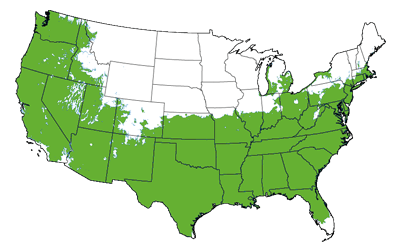Nellie Stevens Holly
Product Details
 Growing Zones 6-9
Growing Zones 6-9
| Soil Type | Acidic, Adaptable, Well Drained |
| Sunlight | Full, Partial |
| Drought Tolerance | Good |
| Fall Color | Green |
| Bloom Color | White |
| Shipping Restriction | AK, AZ, HI, OR |
How far apart should you plant Nellie Stevens?
To create a windbreak or privacy hedge, plant them five to six feet apart. This allows your hollies to grow to their full potential while still creating the privacy and coverage you're looking for. Follow a similar plant spacing when planting hollies near a fence, property line, or structure.
Does this evergreen need to be pruned?
While these trees don't need pruning to maintain their look, they tolerate pruning very well. The Nellie Stevens looks great as a hedge, screen, or specimen plant. It has dark green leaves that are glossy and spiny. This makes it an ideal choice for landscaping and garden design. If you choose to do any heavy pruning, its best reserved for late winter or early spring.
What is the Nellie Stevens Holly tree growth rate?
This is one of the fastest-growing holly varieties available. It's been known to grow up to three feet in just one year!
How tall do Nellie Stevens Holly grow?
The most common use of this evergreen is as a conical privacy shrub. At maturity, these can reach a height of 15 to 30 feet and 8 to 25 feet wide. If you prefer to maintain a smaller tree, it can be shaped to fit your needs by doing some pruning.
Be sure to choose the appropriate location for your Nellie Stevens Holly. As long as you avoid extreme temperatures you can plant your Holly almost any time of the year.
Hollies tolerate full sun to part sun. They prefer a slightly acidic soil, but tend to adapt just about any well draining soil. After planting, adding a layer of 2 to 3 inches of mulch will help keep the soil moist. Mulching is highly recommended in cooler zones to protect the plant's roots in winter as well. Do not allow the mulch to touch the trunk as this increases the chances of pests and disease. Water your Holly deeply a couple times a week for the first few months. After Hollies are established, they only need watered during hot, dry spells. Fertilize in spring with a slow release fertilizer for broad leaf evergreens. The Nellie Stevens Holly doesn't require pruning, but they tolerate it well if you prefer to keep them a certain size. Heavy pruning is best reserved for late winter or early spring.
The best way to prevent disease and pests is by providing the appropriate care for your plants. Proper location choice, watering, and fertilization are the keys to your success. Nellies rarely have issues with pests or disease, but here are a few issues that occasionally affect Hollies. Mites and scale can be treated with horticultural oil. For severe infections the pesticide Bonide is recommended. Avoid saturated soils to prevent fungal issues in Hollies.
Landscaping with Nellie Stevens Holly trees can add beauty and texture to any outdoor space. These trees are evergreen and low-maintenance, making them a popular choice for many homeowners.
It's a great tree for anchoring the sides of your home. Plant one Nellie Stevens on each side of the front of your home. Not only will it anchor each side but it will likely make your home look larger. Add some Kaleidoscope Abelia around each tree for a more colorful landscape design.
For additional options, be sure to browse our Thuja Green Giant as well as our Evergreen tree, Privacy hedge and Privacy tree collections.



















